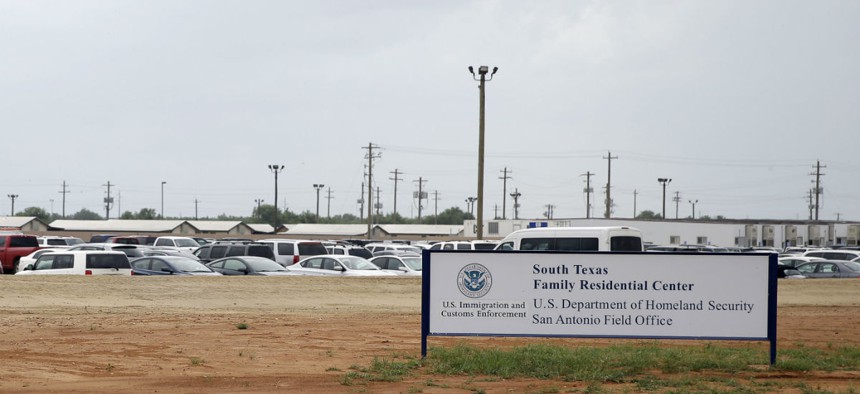
Federal courts have repeatedly deemed the South Texas Family Residential Center unfit to house young children. Eric Gay/AP
The Beginning of the End of Private Detention For Immigrants?
The Homeland Security Department is rethinking its reliance on for-profit prisons. But it’s not enough.
By the end of November, immigrants may no longer be detained in the Homeland Security Department’s much-criticized private detention facilities. In a statement released Monday, Secretary Jeh Johnson asked the Homeland Security Advisory Council, a multidisciplinary committee that weighs in on DHS policy, to examine the “current policy and practices concerning the use of private immigration detention and evaluate whether this practice should be eliminated.”
Following the Department of Justice’s decision to phase out its private prisons, immigration activists have been calling on DHS to do the same. Facilities under both agencies face the same issues: lack of transparency and inhumane conditions. But DHS detention is not supposed to be punitive, which makes the conditions at such facilities especially problematic. The family detention center in Dilley, Texas, (which activists call “baby jail”) was built as a result of a lucrative deal between the government and the now-infamous Corrections Corporation of America. As I’ve previously written, federal courts have repeatedly deemed this facility unfit to house young children.
The DHS-ordered review announced Monday is clearly a step in the right direction, but not a quick enough one. And that has left activists feeling skeptical. “DHS needs to shut these prisons down. The mountain of evidence is already there for DHS to take action,” Julie Mao, enforcement fellow at the National Immigration Project of the National Lawyers Guild, tells CityLab. “We hope this announcement indicates real action rather than another stall tactic.”
Indeed, if this review leads to the demise of such institutions, activists will rejoice. But their grievances won’t end with private facilities. According to a U.S. Civil Rights Commission report, medical neglect, under-heated cells, rats, and abuse of LGBT detainees and religious minorities are common at both private- and government-run detention facilities. (Some DHS agencies are facing class-action lawsuits on these fronts.) Accounts of government-run family detention camps are similarly grim. Here are two legal professionals, Vanessa Sischo and Christina Brown, describing their first visit to a federal detention center in Artesia, New Mexico, via the New York Times magazine:
“I remember the first time I went in,” Sischo said. “I just stopped, and all I could hear was a symphony of coughing and sneezing and crying and wailing.”
“Kids vomiting all over the place,” Brown said.
“There was a big outbreak of fevers,” Sischo said. “It sent an infant into convulsions.”
“Pneumonia, scabies, lice,” Brown said.
Activists hope that pulling the plug on private detention centers will ultimately help dismantle the entire machinery that criminalizes immigrants, keeps them locked up in punitive conditions, and then ejects them out of the country—sometimes to their deaths. “The review also gives DHS an opportunity to review their standards and reliance on detention altogether,” Jacinta Gonzalez, field director for the #Not1More Campaign, said in a statement to CityLab.






